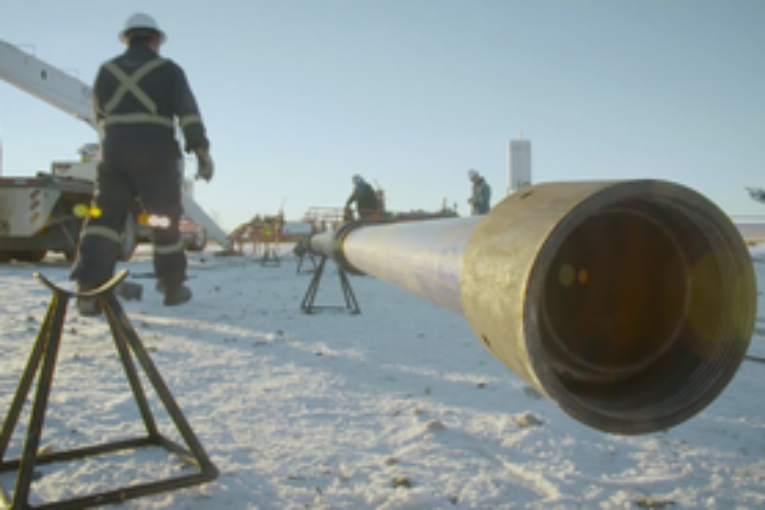
The Daily Oil Bulletin’s first annual Energy Excellence Awards were held in Calgary on Thursday, May 2.
Awards were handed out in 12 categories under the banners of: Operational and Project Excellence, Innovation and Researching Excellence, and Exporting Excellence.
Today we are profiling the Exporting Excellence champion in the Advanced Technology category.
Click here to read about all of the champions and finalists.
The science behind Blue Spark Energy’s oil and gas well remediation technology is that the compression of small quantities of electrical energy and its release in billionths-per-second pulses produces incredible power.
Todd Parker saw the promise of this technology to more efficiently and cost-effectively enhance oil flow in poorly producing wells when he was still Weatherford’s regional vice president for Canada, responsible for 4,000 employees. So he quit his job, drew up a business plan on his daughter’s laptop, launched Blue Spark in 2011 and developed the first prototype tools.
Commercial WASP (Commercial Wireline Applied Stimulation Pulsing) tools followed in 2013, when Blue Spark had to decide whether to focus on domestic sales or take on the more challenging route of chasing a global market. Parker was well aware of oil and gas cyclicality. He also knew that down cycles usually didn’t impact all global regions equally. But cultivating global markets takes time and capital.
“[Going global] was a painful decision at the time, but the right one,” says the chief executive officer of Blue Spark.
Initial enthusiastic uptake of WASP tools flattened in the post-2014 era. But in 2017, Blue Spark returned to robust growth. International sales today account for more 90 per cent of Blue Spark’s total revenues whereas, in the first two years, domestic sales accounted for 90 per cent of revenues.
As an alternative to matrix acidization, hydraulic fracturing, propellants or perforating, WASP tools provide a low-cost, environmentally benign treatment for underperforming wells due to near-wellbore damage—typically scaling, migrating fines, and/or poor completion practices.
WASP is run downhole on a regular wireline cable where it converts small amounts of electricity into shockwaves that stimulate or remove debris from oil wells. Power consumption for treating a typical Alberta oil well is the equivalent leaving a lightbulb on for three or four hours, Parker says. But the resulting pressure pulses of up to 10,000 psi break up and mobilizes brittle material that plug channels of flow within three feet of the wellbore and create micro fractures in the near wellbore rock.
To date, Blue Spark has treated more than 500 wells, achieving an average increase in production of 170 per cent in oil wells and 137 per cent in liquids-rich gas wells. These results have earned it recognition by several local and international technology awards.
As a small company of 15 people, Blue Spark doesn’t tie up its capital on bricks-and-mortar locations. Instead it looks for partnerships and groups that provide synergies for its international expansion.
“We form partnerships almost in every country we go to. Our deployment partners are boots-on-the-ground. Typically, a technician deploys the service in each location,” Parker says.
Currently, Blue Spark’s biggest export market is the North Sea, where it started working in 2013. That year marked another significant decision: If the technology was to work in the offshore market, it had to prove itself in the world’s most demanding offshore market.
“On these expensive offshore platforms, efficiency was that important proposition. The environmental component was also important,” Parker says.
Blue Spark worked with a customer in the North Sea that “took it under its wing” (Maersk Oil, bought by Total in 2018). Maersk saw both the potential in WASP but also its shortcomings, so it helped Blue Spark improve the product for the North Sea market.
“Through that collaboration, we refined our process and improved the technology. When you have a customer on your side, it becomes easier to find [other] local partners,” he says.
Parker notes that Export Development Canada [EDC] was of help in sending Blue Spark people to conferences and begin conversations with foreign customers.
“The EDC has been quite supportive in providing funding. Every time we go, we seem to generate some sort of business on the back of that. EDC has allowed us to go to the Malaysia, West Coast Africa, Ghana, and the United States,” Parker says.
Blue Spark’s track record helps find new partners, most recently in the Middle East.
“We did some work in Saudi Arabia, Oman and Turkmenistan. We also have some opportunities in Egypt, the UAE and other parts of that region,” Parker says.
But the main challenge for Blue Spark remains that it has a unique way of solving a problem that already has established solutions. So convincing people that WASP has a better mouse trap can be a challenge.
“The industry is a little perverse. It doesn’t have a lot of money to spend right now, so you would think it would be more open to money-saving ideas. But it’s the opposite. When you have very little money to spend, you don’t want to risk it on something new,” Parker says.
That was particularly true in 2015 and 2016. Today, with a body of successful work behind it, Blue Spark is met by a more receptive audience.
“It’s now more a matter of continuing to travel to those places, establish meetings and building partnerships and company revenues,” Parker says.
Click here to read about all of the champions and finalists.
You can read more of the news on source
